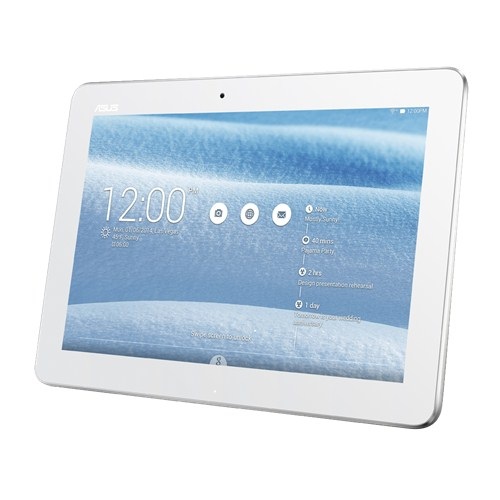REVIEW: Asus Transformer Pad TF103 - Far from cheap and nasty

Asus' Transformer concept is built around the idea of a fully-fledged 10.1-inch Android tablet with a clip-on keyboard to mimic a small notebook. This hybrid design seemed to be the mobility "Holy Grail" back when tablets were first fighting for respect in the portable space.
Unfortunately the early hybrid devices were over-priced, under-specced and simply demanded too many sacrifices. Back in 2011 we were paying $999 for the very first Asus Eee Pad Transformer, with early adopters slugged a hefty "Australia Tax." Skip forward three years and today we have Asus' Transformer Pad TF103, delivering a much slicker package for less than half the money at only $429 for the 16GB model. Aussies are still slugged with a markup, as it sells for $US299 plus tax on the other side of the Pacific.
The basics of the Transformer concept have remained the same over the years -- it's a 10.1-inch Android tablet which locks into a keyboard with a hinge that folds down the screen like a notebook. There's a quick release button on the hinge to free the tablet. The TF103 tablet is 9.9mm thick and weighs in at 545 grams. Once you attach the keyboard the whole thing tips the scales at 985 grams and is 19.8mm thick - not the lightest gadget on the market but still petite enough to lug around on your shoulder all day.
The TF103 is blessed with Android 4.4 KitKat and sports a bright, crisp 1280x800 IPS LCD screen with a 16:10 aspect ratio, vivid colours, wide viewing angles and great contrast. It can't match the 1920x1080 or 2560x1600 resolution found on some high-end Android devices, but the TF103 isn't intended to be a consumer-focused multimedia king to rival something like Samsung's Galaxy S Tab. Likewise, under the bonnet you'll find a 64-bit Intel Atom 1.3GHz quad-core processor accompanied by 1GB of RAM, whereas these days you might expect a faster clock speed and 2GB or even 3GB in a high-end device.
Technically the TF103 is Asus' budget model alongside something like the TF701T which will set you back $799. The TF103 sports a modest but respectable spec sheet in order to keep down the price while still empowering those looking for a portable productivity tool. It has the grunt to do justice to resource-intensive games like Real Racing 3, but it's working on the assumption that you're looking for a travel companion more for work than play.
Features

When you just need a tablet you can leave the TF103's detachable keyboard at home, because it doesn't feature a second battery to boost time between charges. There's a full-sized USB port built into detachable keyboard, but you'll also find a micro-USB port on the tablet itself which doubles as the charge port. The plastic body isn't as slick and sexy as the more expensive aluminium Transformers.
There's no built-in HDMI port on the tablet or the keyboard, which is a frustrating omission if you want to run presentations but once again it's the price you pay for choosing the budget model. The tablet features Bluetooth 4.0, GPS and 802.11a/b/g/n Wi-Fi at 2.4 and 5GHz, with support for Miracast wireless mirroring to compatible televisions and set-top boxes.
Turn the tablet over in your hands and you'll find a micro-SD slot, power button and volume rocker, but there's no slot for a SIM card to support mobile broadband. You'll also find a 2 megapixel camera on the back and 0.3 megapixel on the front, the latter of which is disappointing even for a budget device if you were hoping for half-decent Skype calls. Even incoming Skype calls look shabby and would benefit from some extra graphics grunt.
Keyboard, Trackpad and Touchscreen
And so we come to the keyboard and trackpad -- the features which make or break a productivity device if you spend your days typing. Asus has reworked the keyboard and the keys feel pretty good, they have plenty of travel but don't feel squishy and the casing doesn't flex as you type. The overall build quality of both the tablet and the keyboard is solid and you can pick it up by the screen without fear of damage.
Unfortunately the keys are a little small for my liking but you can make do and most of this review was written on the TF103. With other cramped keyboards I've been known to give up in disgust and switch back to my MacBook Pro but if you persevere with the TF103 it grows on you.
Support for standard keyboard shortcuts in apps like Google Docs certainly helps, but this can vary from app to app. The half-sized right Shift key will frustrate some touch typists. Thankfully Asus had the sense to make Page Up, Page Down, Home and End keys reliant on the Function key, rather than cramming them alongside the Arrow keys where you might hit them too easily by accident.
The trackpad is a reasonable size and well-placed, although by default it's a little too sensitive. It's sometimes difficult to click on items or place the cursor because the trackpad detects the slightest of sideways movements and thinks you're trying to move the pointer.
Thankfully you can tone this down in the settings and reconfigure the right-click to call up contextual menus rather than acting as the Back button -- a frustrating default setting. It doesn't seem possible to disable tap to click, but the row of function keys across the top of the keyboard lets you disable the trackpad completely. You'll also find a Settings button along with the usual suspects such as brightness and multimedia controls.
The trackpad also supports smooth two-finger scrolling, but it's surprising how quickly you take to the touchscreen when you're in the familiar Android environment. After a while you find yourself seamlessly code-switching, as linguists would say, between the languages of type and touch.
If you live on the road the TF103 is unlikely to cut it as your primary workhorse. Unfortunately as a notebook it's a little top heavy so it's prone to slight rocking when you try to type on your lap. If you spend your days slaving away at a keyboard then think twice before abandoning a traditional notebook, but the TF103 makes a respectable secondary device for those times when you're away from the office.
Detach the keyboard and you're presented with a respectable onscreen keyboard offering surprisingly good autocorrect. Hold the tablet in portrait mode and you can split the keyboard in half, to type with two thumbs, and slide it up or down the screen to rest it where it suits you best.
Software
I'll admit I cringed when I saw that Asus has reskinned KitKat with "ZenUI", but just like the rest of the TF103 it's surprisingly slick and very much focused on productivity. ZenUI clean and elegant rather than overly-chirpy (yes Samsung, I'm looking at you), using the What's Next feature to intelligently pull information from your calendar along with smart reminders, such as alerting you to unread messages from important people. As well as a standalone app, What's Next is also integrated into the lock screen and desktop.
Meanwhile, the Do It Later feature acts as a reminder service which is integrated into other apps. You'll also find the SuperNote app with support for touch, type, images, audio and video -- although it's important to note that the TF103 doesn't come with a stylus.
The usefulness of these features comes down to personal preference, but Asus has laid a good foundation that works with you rather than against you.
The other key factor with portable productivity tools is battery life and here the TF103 fares well but could struggle to get you through a solid day. Asus' promise of nine hours seems optimistic unless you suffer through brutal power-saving features, such as automatically dimming the screen for certain apps and regularly killing wireless connectivity. If your power settings are a bit less draconian you should still manage to squeeze at least five to six solid hours from the TF103.
What’s the verdict?
With a device like this it really comes down to whether Android can meet all your productivity needs and whether you really need that detachable keyboard. If you're prepared to look to a standalone Bluetooth keyboard you might find something a bit less cramped, and combine it with a standalone tablet sporting higher specs, but you lose the advantage of the hinge and notebook-style design.
You're still making sacrifices in the pursuit of all-in-one convenience, but they're much less painful and the sub-$500 price tag also makes it easier to forgive the Transformers' shortcomings compared to its predecessors. As the budget model it lacks a little elegance but it's far from cheap and nasty. If you're frustrated by specific items on the spec sheet -- like the lack of a secondary battery in the keyboard -- then consider stepping up to the $799 TF701T. But if you're a price-conscious shopper who has been eyeing off Android Hybrid devices with caution, the TF103 may finally be the droid that you're looking for.
















